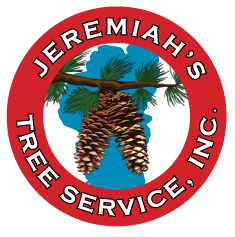Tree Health Care | Jeremiah’s Tree Service
At Jeremiah’s Tree Service, we’re passionate about preserving the natural beauty and health of Lake Tahoe’s unique landscape. Our Plant Health Care (PHC) program is tailored specifically to the needs of trees and shrubs in the Tahoe Basin, addressing the region’s distinct environmental challenges and diseases.
Whether you’re looking to enhance the health of your property’s trees or protect them from pests, disease, and environmental stressors, our certified arborists are here to help. We offer customized plant health care programs designed to meet the unique needs of each tree, taking into account species, soil conditions, climate, and other factors. With proactive treatments, regular monitoring, and expert guidance, we ensure your trees not only survive—but truly thrive—for years to come.

What Is Plant Health Care?
Plant health care is a holistic approach to tree care that focuses on developing and maintaining healthy plants throughout their lifecycle. This proactive tree health care strategy involves regular monitoring, proper watering, nutrient management, and timely interventions to prevent problems before they escalate. Plant health care programs are designed to keep trees healthy and resilient, reducing the likelihood of decline and the need for costly treatments or removal later on.
By addressing potential issues early, our certified arborists can help ensure your trees thrive. Embracing a holistic approach to tree care not only promotes the well-being of your trees but is also a cost-effective way to manage your property’s greenery.
Why Plant Health Care Matters in Lake Tahoe
Lake Tahoe’s breathtaking scenery is home to a variety of tree species, including Jeffrey pines, sugar pines, white firs, and quaking aspens. However, these trees face numerous challenges, such as:
- Drought Stress: Periods of low precipitation and sandy, fast-draining soils can lead to water scarcity, weakening trees and making them more susceptible to insects and diseases. Additionally, poor soil conditions can exacerbate these issues, further stressing the trees.
- Bark Beetles: Infestations from beetles, such as engraver beetles, are a significant threat to specific trees like Tahoe’s conifers.
- Root and Needle Diseases: Fungal infections like root rot and needle blight can compromise tree health and stability.
- Invasive Species: The spread of invasive species, such as shothole borer, pose a growing risk to local flora.
- Fire Risk: Healthy trees are more resilient to fires, an ongoing concern in the Lake Tahoe area.
Our Comprehensive Plant Health Care Approach
At Jeremiah’s Tree Service, we believe in a proactive, holistic approach to treat trees. Our certified arborists are trained in various risk management practices, which include identifying defects in trees and understanding the standards required to mitigate these risks, ensuring safety during tree care and maintenance. Our PHC process includes:
1. Tree Inspections and Assessments
Our arborists will evaluate your trees for signs of stress, pest infestations, diseases, and structural issues. Early detection of symptoms is key to maintaining health and preventing costly removals.
2. Soil Management, Soil Compaction, and Fertilization
Healthy soil is the foundation for thriving trees. Maintaining the soil surface around trees is crucial for optimal moisture retention and tree health. We offer soil testing, aeration, and custom fertilization plans to ensure your trees receive the nutrients they need to grow strong and resilient.
3. Pest and Disease Management
We use environmentally responsible treatments to control insects and diseases, including targeted insecticide applications, fungicides, and biological controls. One common pest is bark beetles. These insects burrow into the conifers, disrupting nutrient flow and causing tree death if not treated promptly.
4. Drought Mitigation
To combat water scarcity, we implement measures such as deep root watering, mulching, and irrigation system recommendations to keep your trees hydrated and healthy. Mulching retains moisture for the roots, ensuring they have adequate supply.
5. Growth Management
Proper growth management helps maintain the structural integrity and aesthetics of your trees. Our arborists employ strategic pruning techniques to control growth, improve canopy structure, and reduce the risk of limb failure. Growth regulation treatments may also be used to slow excessive expansion, particularly in confined urban spaces or near utility lines.
6. Root Care and Excavation
Healthy roots are essential for tree stability and nutrient uptake. We provide air spading services to safely expose roots without causing damage, allowing for better diagnosis and treatment of issues like girdling roots and soil compaction. Additionally, we offer root pruning and support solutions to protect trees during construction projects or landscaping modifications.
Newly Planted Tree Care
New trees require proper care to establish a strong root system and promote healthy maturation. Here are some essential tips for new tree care:
- Watering: Ensure your newly planted tree receives adequate water, especially during its first year. Aim to provide about 1 inch of water per week, either from rainfall or irrigation, to help the tree establish its roots.
- Mulching: Apply a thin layer of mulch (about 2-3 inches) one foot from the base of the tree to retain moisture, suppress weeds, and regulate soil temperature. Be careful not to pile the mulch against the trunk, as this can lead to rot.
- Fertilization: Avoid fertilizing your young tree during its first year. Instead, focus on providing sufficient nutrients through the soil to support its initial growth.
- Pruning: Prune your newly planted tree to keep its shape and encourage healthy growth. Remove any dead or damaged branches and thin out the canopy to allow sunlight to reach the inner branches.
By following these tips, you can ensure your new tree receives the proper care it needs to thrive and become a healthy, mature tree. Contact us today to schedule your personalized tree health consultation. Let our experts help you preserve the natural beauty of Lake Tahoe.
The Benefits of Plant Health Care (PHC) and Cost Savings of Preservation
Plant Health Care (PHC) is a proactive approach to tree care that focuses on maintaining tree vitality, preventing disease, and mitigating environmental stressors before they become severe issues. By investing in PHC, property owners can extend the lifespan of their trees, enhance landscape aesthetics, and reduce the need for costly interventions.
Cost Benefits of Preservation vs. Removal
One of the primary advantages of PHC is the significant cost savings compared to tree removal. A well-maintained tree can provide decades of environmental and aesthetic benefits, whereas removal is a one-time expense that can be costly, especially for large or hazardous trees. Tree removal involves not only cutting and disposal but also potential stump grinding and site restoration, all of which add up. In contrast, PHC programs—such as soil management, pest and disease control, and structural pruning—help trees thrive and avoid premature removal.
Reduced Pruning Frequency and Long-Term Savings
Regular PHC reduces the need for frequent pruning. When trees receive proper nutrition, soil care, and pest management, they develop stronger structures with fewer weak or dead limbs, meaning less pruning is required over time. While periodic trimming is still necessary for safety and aesthetics, healthy trees require less frequent and less intensive maintenance, lowering overall tree care costs.
By prioritizing PHC, property owners can maintain the value and beauty of their trees while reducing the financial burden of emergency removals and excessive maintenance. Investing in tree preservation is a smart, cost-effective strategy for long-term landscape management.
Common Tree Health Issues
Trees can be susceptible to various health issues that can compromise their vitality and longevity. Here are some common tree health symptoms and how to address them:
- Soil Compaction: Compacted soil can hinder a tree’s ability to absorb water and nutrients, leading to decline and potential death. Avoid compacting the soil around your trees and consider aerating the soil to improve its structure and promote root health.
- Environmental Stresses: Drought, temperature extremes, and pollution weaken trees, making them prone to bark beetles and diseases like root rot. Provide your trees with proper care, including adequate watering, fertilization, and pruning, to help them withstand these environmental stresses.
- Pests and Diseases: These can cause significant damage to trees if not addressed promptly. Regularly monitor your trees for signs of infestation or infection, and consult with a certified arborist if you suspect a problem. Early detection and treatment are crucial for maintaining tree health.
By understanding and addressing these common tree health symptoms, you can help ensure your trees remain healthy and resilient, contributing to the overall well-being of your landscape. Our tree health care resources and treatments provide many benefits for the beauty and overall life of your greenery.
Contact Jeremiah’s Tree Service for Tree and Plant Health Care
Jeremiah’s Tree Service has deep roots in the Lake Tahoe community. Our team understands the specific challenges of this high-altitude environment and is committed to sustainable tree care practices. We work closely with local agencies, including the Tahoe Regional Planning Agency (TRPA), to ensure all of our business aligns with regional regulations and environmental goals.
Your trees are an essential part of Lake Tahoe’s natural beauty and ecological health. Let us be your partner in preserving them. We’ll identify tree health concerns, develop a targeted maintenance plan, and provide expert care to enhance and protect your property’s landscape. Whether you’re a business owner or a homeowner, contact us today to schedule a consultation and learn how our Plant Health Care program can protect and enhance your landscape.
